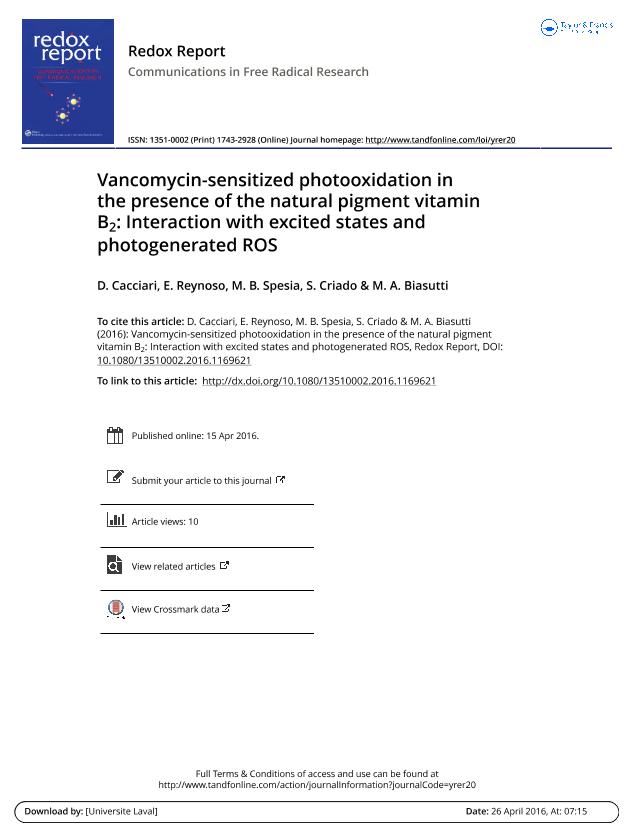Artículo
Vancomycin-sensitized photooxidation in the presence of the natural pigment vitamin B2: Interaction with excited states and photogenerated ROS
Cacciari, Rodolfo Daniel ; Reynoso, Eugenia
; Reynoso, Eugenia ; Spesia, Mariana Belen
; Spesia, Mariana Belen ; Criado, Susana Noemi
; Criado, Susana Noemi ; Biasutti, Maria Alicia
; Biasutti, Maria Alicia
 ; Reynoso, Eugenia
; Reynoso, Eugenia ; Spesia, Mariana Belen
; Spesia, Mariana Belen ; Criado, Susana Noemi
; Criado, Susana Noemi ; Biasutti, Maria Alicia
; Biasutti, Maria Alicia
Fecha de publicación:
04/2016
Editorial:
Maney Publishing
Revista:
Redox Report
ISSN:
1351-0002
Idioma:
Inglés
Tipo de recurso:
Artículo publicado
Clasificación temática:
Resumen
Sensitized photooxidation processes in the presence of natural pigments may provide an alternative to antibiotics degradation since these compounds are transparent to natural light irradiation, therefore, they can be degraded by the action of photosensitizers which absorb light and produce highly reactive species, especially those derived from molecular oxygen (ROS). Most antibiotics used currently belong to a group of pharmaceutical substances that have been considered a new type of contaminants due to their persistence and bioaccumulation in the environment. Objective: In this context, we decided to investigate the kinetic and mechanistic aspects of Vancomycin (Vanco) photosensitized degradation in the presence of the natural pigment Riboflavin (Vitamin B2, Rf) and the artificial dye Rose Bengal (RB) for comparative purposes. Methods: The study have been done by using Stationary photolysis, Laser flash photolysis, Time-resolved phosphorence detection of O2(1Δg) experiments and Bactericidal activity evaluation. The experiments were carried out in aqueous solution at different pH values in order to establish relationships between the structure of the compound and its susceptibility to ROS-mediated photooxidation. Results: Experimental evidence indicates that in the presence of Rf there is considerable contribution of the radical-mediated mechanism, while in the presence of RB the photooxidation process occurs exclusively through O2(1Δg) and the reactivity to this excited species increases with increasing pH of the environment. Discussion: The results obtained, have been shown that Rf can raise the photodegradation of Vanco by both the radical pathway and the O2(1Δg) mediated. Furthermore, the antibiotic is able to interact with the excited electronic states of Rf as well as O2(1Δg) generated by energy transfer between the excited triplet state of the photosensitizer and the oxygen ground state. The predominant mechanism for photodegradation of Vanco in the presence of the Rf is the radical via because of the considerable interaction with the excited triplet state of the photosensitizer demonstrated by laser flash photolysis experiments. Microbiological test on Staphylococcus aureus ATCC25923 showed that the bactericidal activity of the antibiotic on the strain studied was affected by the sensitized photodegradation process, suggesting that photoproducts generated eventually do not retain the bactericidal properties of the original antibiotic.
Archivos asociados
Licencia
Identificadores
Colecciones
Articulos(CCT - CORDOBA)
Articulos de CTRO.CIENTIFICO TECNOL.CONICET - CORDOBA
Articulos de CTRO.CIENTIFICO TECNOL.CONICET - CORDOBA
Citación
Cacciari, Rodolfo Daniel; Reynoso, Eugenia; Spesia, Mariana Belen; Criado, Susana Noemi; Biasutti, Maria Alicia; Vancomycin-sensitized photooxidation in the presence of the natural pigment vitamin B2: Interaction with excited states and photogenerated ROS; Maney Publishing; Redox Report; 22; 4; 4-2016; 166-175
Compartir
Altmétricas



